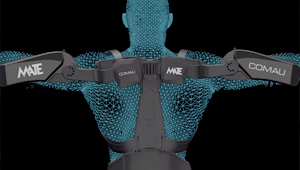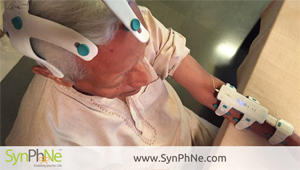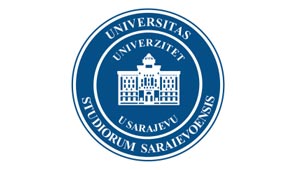Exoskeletons towards Industrie 4.0: Implementation as a Communication Tool in Manufacturing
Fraunhofer IPA
GERMANY
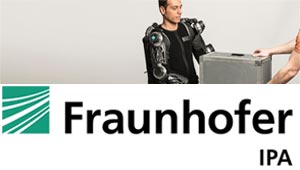
During the last decade, the benefits of exoskeletons for industrial purposes as ergonomics tools have been studied with successful results. They help to reduce fatigue and prevent injuries during lifting, carrying, pushing, pulling, and overhead-positions tasks. Also exoskeletons have benefits as a communication tool in smart factories. they could interact with other systems such as automated guided robots in the supply chain, assembly tools, automated machines, and autonomous software, saving time during the assembly process of different products and reducing faults from operators.
Cybernics Treatment with Wearable Cyborg HAL for Functional Improvement
Cyberdyne Europe GmbH
GERMANY
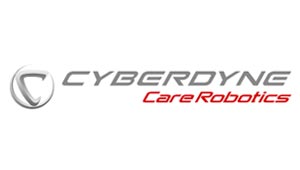
HAL® [Hybrid Assistive Limb®] from Cyberdyne Inc., Japan, is the world‘s first cyborg-type robot, by which a wearer‘s bodily functions can be improved, supported and enhanced. When a person moves the body, various signals are sent from the brain to muscles through nerves. Those signals leak on the skin surface as “bio-electric signals [BES]”. HAL for Medical Use - Lower Limb Model reads the wearer’s BES, accordingly compensates muscle power of lower limbs and assists him or her in walking, standing-up and sitting-down with his or her own legs. The brain confirms how the body moved on what sort of signals and becomes able to learn the way to emit necessary signals for walking gradually. This leads to the important first step in walking of a physically challenged person without being assisted by HAL®. Wearing of HAL® leads to a fusion of “man”, “machine” and “information”.
Powerful Predictive Human Motion Models
Universität zu Lübeck
GERMANY

In the talk we will discuss how a probabilistic model can be used to predict complex human movements from observing only a few milliseconds of a subset of all recorded limb trajectories. The model can handle partial observable, missing data and is robust to sensor noise. In a postural control experiment, I demonstrate how this model can be used to predict goal directed right arm motions solely from observing the motion of the trunk or left arm. The model can be also used for active Exoskeleton control, model validation, classification or movement analyses and is as such interesting for a broad range of research approaches working with multi-modal motion data.
Machine Learning Techniques for Human-Robot Collaboration: Design and Validation of Control Algorithms
Swiss AI Lab IDSIA (Istituto
Dalle Molle di Studi sull'Intelligenza Artificiale)
SWITZERLAND
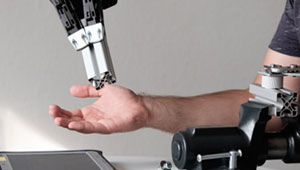
The presentation will described machine learning approaches that have been applied to the human-robot collaboration, considering the I4.0 scenario. In particular, the main focus is on the assistance and empowering of human operators in onerous and heavy applications. By identifying the intention of motion of the human (e.g., mapping the interaction dynamics), such approaches allow to support the operator even during the manipulation of unknown weight parts. The propsoed approaches have been validated in order to show the obtained high-performance in the human-robot co-manipulation of heavy parts. Such techniques have been firstly applied to a colaborative robot (KUKA iiwa 14 R820) and are going to be applied to an exoskeleton that has been designed within the CNR-STIIMA research institute.
Lower-limb powered exoskeleton in gait rehabilitation – customers satisfaction with the device and the related services in Finland
University of Eastern Finland
FINLAND
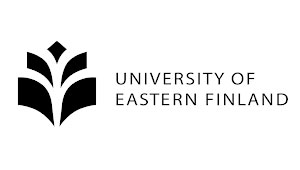
Powered lower-limb exoskeletons are a new form of gait rehabilitation. There are little data on the users’ satisfaction with devices and related services. We have evaluated customers satisfaction of lower limb exoskeletons and related services in Finland.
Textile-based soft wearable actuators
Technische Universität Chemnitz
GERMANY

We will present the fabrication of two types of textile-based soft inflatable actuator which are made of a bladder wrapped by textile and tongyonged inside textile parallel channels. The first actuator is made at different sizes to be used in a large range of wearable applications such as soft exosuits. Five actuator were attached to a commercial glove fingers and form a wearable glove, the glove shows different gestures and it is able to lift 9 [kg] weights. With a larger scale, the actuator was able to lift 20 [kg]. The second actuator shows flexible and versatile behaviour by exhibiting a wide range of motions such as bending, expanding, and twisting. Hybrid actuation (cable-driven, and pneumatics) allows online programing of behaviour and therefore a potential use in soft wearable exosuits.
Development of an exoskeleton for elderly to support stair ascent and descent
Leipzig University of Applied Sciences (HTWK Leipzig)
GERMANY

In case of weak muscle power elderly people often have problems during stair ascent and descent. An exoskeleton for elderly that support the movement of stair negotiation could be a solution to avoid these problems, also as an alternative to stair lifts. The vision of this exoskeleton and the setting of the requirements will be presented first. To set the requirements, we conducted a biomechanical study with elderly and young people and investigated the moments in the lower limb with AnyBody Modeling System™. After that the conceptual and detailed design of the exoskeleton will be shown. The result of the research and development is a first prototype of the exoskeleton for the special movement of stair negotiation.
Benchmarking Industrial Exoskeleton Technology: Moving in Narrow Spaces
CTAG Automotive Technology Centre of Galicia
SPAIN
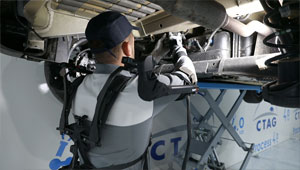
We will present the work in progress and lesson learned from the development of TestEd project. TestEd aims to design a testbed and software routines for “Moving in Narrow Spaces”. We will link three use-cases from the manufacturing industry. The industrial exoskeleton centered TestEd will be implemented in industry with confidence. It is important to note the present method is efficient in identifying the local evaluation criteria performance of an exoskeleton in scientific fashion but lack the global performance perspective. Today, we predominantly use our experience and intuition for global performance. We like proposing the development of testing performance matrices on the basis of local and global performance. TestEd will develop performance matrices for the evaluation of the local and global evaluation criteria. It will provide a scientifically validated performance metric that can help testers, users and the OEM to quickly test their devices both in terms of the local evaluation criteria and global performance of the device. It can also lay the ground for the development of business models for the certification bodies around Europe.
Occupational exoskeletons: From laboratory research to integration in the companies
The French National Research and Safety Institute for the Prevention of Occupational Accidents and Diseases(INRS)
FRANCE
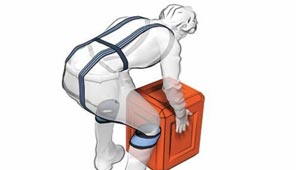
To deal with the prevalence of musculoskeletal disorders (MSD) in physically demanding tasks, research is focusing on the use of exoskeletons. Based on the available evidence underlying the claimed efficiency of exoskeletons in reducing biomechanical strains at work, this communication firstly aims at discussing the benefits and potential musculoskeletal risks associated with using these devices. At the light of the main deficiencies in current knowledge, the research necessary to develop future generations of exoskeletons also are presented. But, even if the potential of exoskeletons to attenuate muscular strains seems promising in laboratory, the ability to determine the value proposition of an exoskeleton in the workplace is difficult due to the variety of methods and metrics used, and the protean character of these technologies. In a second part, this communication presents a standard framework for the evaluation of the human-exoskeleton interaction, with the hope to improve their future integration.
A review of CEA's robotic contributions to exoskeleton design and control for limb mobilisation and load carrying assistance: From ABLE to HERCULE and EMY.
The French Alternative Energies and Atomic Energy Commission (CEA)
FRANCE

Over the 15 last years, the CEA robotic service has developed several types of exoskeletons both for upper and low limb, as well as innovative technologies covering the mobilization of limbs through Brain Computer Interface for medical applications and the assistance to carry loads for the industry. This presentation is the occasion of reviewing these main innovations and to propose a classification in terms of architecture, actuators and control methods.
User Requirements on Exoskelettons for Working Environments
YOUSE
GERMANY

The technical possibilities of exoskeletons have the potential to help logistics employees to work more ergonomically, reduce illness and make employee deployment more flexible. However, like all technical aids, exoskeletons intervene directly in the work system and must be used and accepted by the employees. As part of the BMVI-funded research project KALI, YOUSE conducted a field test of an exoskeleton over several months. User requirements for the design of exoskeletons were collected, which can improve further developments and future research. In this presentation we would like to give an insight into this work and the user perspective on exoskeletons and present possible obstacles in the implementation of the technology in the context of logistics.
Ironhand-Best practice with Eiffage Infrastructures
Bioservo
SWEDEN

More details to come www.bioservo.com
Towards an enhanced workforce: moving from technological to managerial challenges
University of Twente
NETHERLANDS
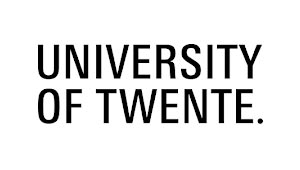
This presentation analyses the challenges that are raised by introducing human enhancement technologies to the workplace, for the purpose of making both the individual and the organisations perform better. A typology of approaches to organisational enhancement is described. We show how available technologies match these needs and highlight gaps which can inspire future developments by engineers. Then, we take one step further and question the acceptance and efficiency of such technologies. We show based on empirical data collected in an organization testing wearables for augmentation that resistance to the augmentation practice comes down to how organizations manage the implementation of the technology. It opens questions to how the technology can be designed for more procedural justice and areas for future research collaboration between developers, engineers, and social scientists, to shape the development of the augmentation market.
Modeling the Physical Human-Exoskeleton Interface
Politecnico di Torino (Royal Turin Polytechnic)
ITALY

Digital human models are used extensively in the design and dynamic analysis of exoskeletons. The assistance provided by exoskeletons is received by the user at the physical human-exoskeleton interface. Therefore, correct simulation of the interface forces is crucial for simulating the dynamics of the human-exoskeleton system. Often, the human-exoskeleton interface forces are estimated through the use of rigid kinematic joints. However, in reality, the interfaces are formed by straps, cuffs or molded surfaces. In this work, a new approach to model the interface forces is presented, potentially allowing the simulation of curved surfaces and friction at the interface. A case study on Chairless Chair will be used to discuss the key aspects of modeling the physical human-exoskeleton interface.
Myontec Ergoanalysis in assessing benefits of an exoskeleton in reducing upper extremity work load
Myontec
FINLAND
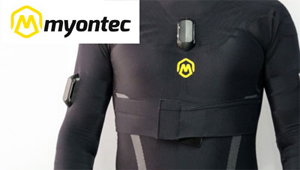
Myontec’s Ergoanalysis™ is a novel method used to measure work related physical loading at workplaces with smart clothing combining hand and shoulder electromyography (EMG), upper extremity and back movements as well as heart rate. The wearable technology is patented and scientifically validated. Portable devices and apps are used to execute the measurements wirelessly. Web application ErgoLink and ErgoAnalysis Cloud Service are platforms for data analysis, reporting, data storage and data transfer to the client. The ErgoanalysisTM Quick Report includes algorithms taking into account scientific recommendations for maximum work physical loading. ErgonalysisTM can be a fast tool in visualizing benefits of an exoskeleton in reducing upper extremity physical loading during a work phase. e more at www.myontec.com
Numerical analysis and ergonomic evaluation of exoskeletons with digital human simulation – A general framework and the “PAEXO” case study
imk automotive GmbH
GERMANY
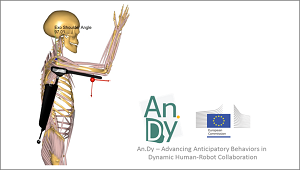
The goal of this work is to study the possibilities for numerical simulation of the effects of exoskeletons on biomechanical and physiological properties of the human body using the AnyBody Modelling System (AMS). AMS provides a digital human model of the entire body including muscles, bones and tendons. It allows the simulation and evaluation of physical activities with and without existing exoskeleton products or prototypes. Moreover, it may be used for investigating and optimizing virtual prototypes of new exoskeletons and conducting studies on different anthropometric populations with less effort. In our presentation, we will provide a general framework for using digital human simulation to study exoskeletons. Moreover, we will present a case study using AMS on “PAEXO Shoulder” by Ottobock.




